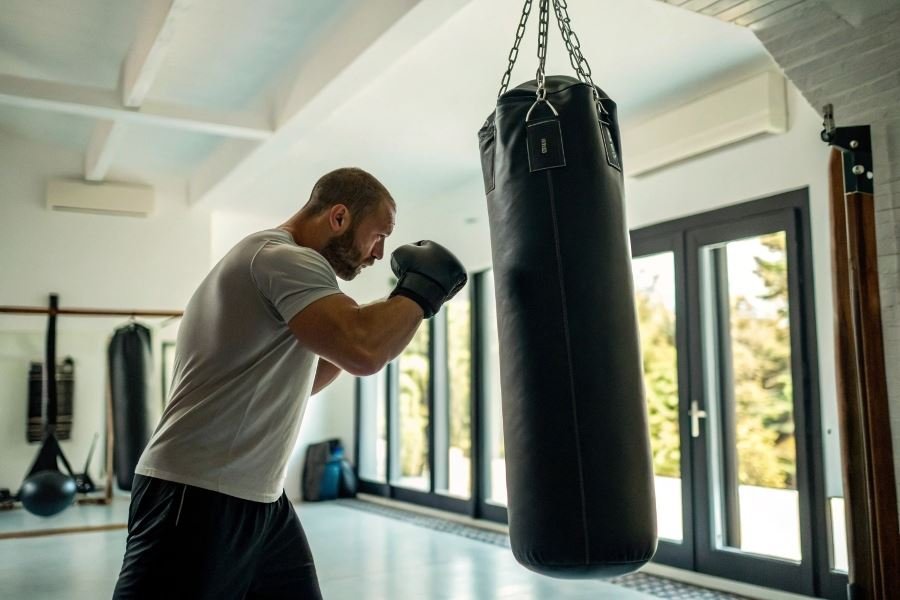
Ever thrown a punch that felt like pure liberation? That’s the magic of having a punching bag right in your living space. Beyond just being a piece of equipment, a home punching bag transforms ordinary rooms into personal training sanctuaries.
Choosing the right punching bag for home training isn’t just about buying something to hit—it’s about creating a relationship with a training partner that will help shape your fitness journey. Whether you’re looking to blow off steam after work, improve your technique, or get a full-body workout without leaving your garage, the right bag makes all the difference.
The hidden benefits of punching at home
A home punching bag delivers more than just convenience. Regular sessions can burn up to 400 calories per hour while building core strength and improving coordination. Plus, there’s the undeniable stress relief that comes from throwing combinations after a challenging day—no gym membership required.
Know your bags: Finding your perfect match
Heavy bags (70-150 pounds) offer solid resistance for power development and are the workhorses of boxing training. Speed bags improve hand-eye coordination and rhythm. Free-standing bags require no installation and can be moved easily, while wall-mounted options save space but need proper structural support.
Before you buy: The crucial considerations
Your available space will dictate possibilities—ceiling height matters for hanging bags, while floor space determines free-standing options. Consider your training goals: Are you focusing on technique, power, or cardio? Your experience level matters too—beginners might prefer softer bags while advanced fighters need denser materials for resistance.
Weight, filling material, and mounting options aren’t just technical details—they’re the difference between a bag that becomes your favorite training tool and one that collects dust in the corner.
Essential Criteria for Selecting the Perfect Home Punching Bag
Finding the right punching bag for home training transforms your workout space from ordinary to extraordinary. The difference between a good session and a great one often comes down to having equipment that matches your specific needs and training style.
When exploring how to choose a punching bag for home training, three critical factors determine whether your investment will deliver results or disappointment: weight and size specifications, material quality, and mounting considerations. Each element plays a crucial role in creating a training experience that keeps you coming back day after day.
Weight and Size: Matching Your Training Goals
The weight and dimensions of your punching bag directly impact your training effectiveness and safety.
For beginners and technique-focused training: Lighter bags (40-70 lbs) provide less resistance and faster rebound, perfect for developing proper form and speed.
For power development and heavy hitters: Heavier bags (70-100+ lbs) absorb powerful strikes without excessive swing, ideal for developing knockout power.
For kickboxing and MMA training: Longer bags (4-5 feet) accommodate both punches and kicks at various heights.
Your body weight should also influence your selection:
| Your Weight | Recommended Bag Weight |
|---|---|
| Under 150 lbs | 70-80 lbs |
| 150-180 lbs | 80-100 lbs |
| Over 180 lbs | 100+ lbs |
Remember that ceiling height is crucial—allow at least 3-4 feet of clearance above the bag for proper swing and movement.
Material Quality and Durability Assessment
The construction of your punching bag determines both its performance and longevity.
Outer covering options:
- Genuine leather: Premium feel, excellent durability, and ages beautifully but comes at a higher price point
- Synthetic leather: Nearly matches genuine leather’s performance at a more accessible price
- Canvas: Budget-friendly but less durable and potentially rougher on hands
Fill materials matter tremendously:
Traditional bags use combinations of:
- Textile scraps for firmness
- Sand for weight and stability
- Shredded rubber for shock absorption
Modern Everlast and Century bags often feature specialized foam cores that provide consistent density throughout the bag’s lifespan.
Pro tip: Tap the bag in different spots—quality bags produce a consistent sound throughout, indicating even fill distribution.
Water-filled bags from brands like Aqua Training Bag offer adjustable resistance and superior shock absorption that’s gentler on joints.
Mounting Options and Space Requirements
Your available space dictates which mounting solution works best:
Ceiling mounts provide the most authentic swing and movement but require:
- Solid ceiling joists or beams
- Minimum 8-foot ceilings
- Approximately 4-5 feet of clearance in all directions
Wall mounts work in spaces with limited floor area but:
- Reduce natural bag movement
- Require sturdy wall construction (concrete or reinforced studs)
- Still need about 3-4 feet of side clearance
Free-standing bags offer maximum flexibility:
- No permanent installation required
- Can be moved or stored when not in use
- Typically require a 5×5 foot footprint
- May have less stability during intense sessions
For apartment dwellers, Ringside’s spring-loaded mounts or Title Boxing’s door frame systems provide noise-dampening benefits that neighbors will appreciate.
Selecting the right punching bag involves balancing these factors against your training goals, available space, and budget—but getting it right means creating a home training environment that delivers professional-level results.
Sealing the Deal: Your Perfect Punching Bag Awaits
Finding the right punching bag for your home gym isn’t just about picking the heaviest or prettiest option on the shelf. It’s about making a strategic investment in your fitness journey. Let’s cut through the noise and zero in on what really matters when finalizing your decision.
Smart spending for serious training
Budget considerations shouldn’t be an afterthought—they’re central to your decision-making process. Quality punching bags typically range from $80 for basic hanging models to $500+ for premium freestanding options with advanced features.
The cheapest bag isn’t always the most economical. Factor in durability, warranty, and replacement costs when calculating true value.
Consider this value equation:
- Entry-level ($80-150): Great for beginners, but may need replacement within 1-2 years of regular use
- Mid-range ($150-300): The sweet spot for most home trainers—balancing quality and affordability
- Premium ($300+): Professional-grade construction that can withstand years of punishment
Remember that accessories like gloves, wraps, and mounting hardware often aren’t included, potentially adding $50-100 to your initial investment.
Top contenders for your corner
Different training styles demand different equipment. After testing dozens of models, these three consistently deliver knockout performance:
For technical boxers: Everlast Nevatear Heavy Bag
The Everlast Nevatear 70lb hanging bag offers the perfect combination of resistance and feedback. Its reinforced seams and premium synthetic leather construction make it ideal for developing precise combinations and improving timing.
For MMA and versatile training: Century Wavemaster XXL
The Century Wavemaster XXL freestanding bag provides stability during intense sessions while allowing easy repositioning. Its large striking surface accommodates everything from boxing combinations to devastating low kicks.
For power punchers: Outslayer 100lb Heavy Bag
The Outslayer 100lb bag is virtually indestructible with its military-grade vinyl exterior and dense fabric fill. When you need to develop raw power without worrying about damaging your equipment, this is your go-to option.
Extending your bag’s fighting life
Even the toughest punching bags need proper care. Implement these maintenance practices to maximize your investment:
- Rotate regularly – Turn hanging bags 1/4 turn weekly to prevent uneven wear and filling settlement
- Clean after sweaty sessions – Wipe down with a damp cloth and mild soap to prevent material breakdown
- Check hardware monthly – Inspect chains, straps, and mounting points for signs of wear
- Address damage immediately – Small tears become big problems; patch minor damage before it spreads
For freestanding bags, drain and refill the base every six months to prevent leaks and maintain stability. Store all bags away from direct sunlight when possible, as UV exposure degrades materials over time.
By balancing your budget considerations with your specific training needs and implementing a solid maintenance routine, you’ll ensure your punching bag remains a reliable training partner for years to come. The perfect bag isn’t just about what feels right today—it’s about what will continue to challenge and support your development tomorrow.
